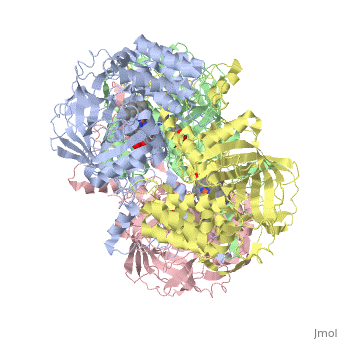1qqw: Difference between revisions
Jump to navigation
Jump to search
No edit summary |
No edit summary |
||
| (5 intermediate revisions by the same user not shown) | |||
| Line 1: | Line 1: | ||
==CRYSTAL STRUCTURE OF HUMAN ERYTHROCYTE CATALASE== | ==CRYSTAL STRUCTURE OF HUMAN ERYTHROCYTE CATALASE== | ||
<StructureSection load='1qqw' size='340' side='right' caption='[[1qqw]], [[Resolution|resolution]] 2.75Å' scene=''> | <StructureSection load='1qqw' size='340' side='right'caption='[[1qqw]], [[Resolution|resolution]] 2.75Å' scene=''> | ||
== Structural highlights == | == Structural highlights == | ||
<table><tr><td colspan='2'>[[1qqw]] is a 4 chain structure with sequence from [ | <table><tr><td colspan='2'>[[1qqw]] is a 4 chain structure with sequence from [https://en.wikipedia.org/wiki/Homo_sapiens Homo sapiens]. The September 2004 RCSB PDB [https://pdb.rcsb.org/pdb/static.do?p=education_discussion/molecule_of_the_month/index.html Molecule of the Month] feature on ''Catalase'' by David S. Goodsell is [https://dx.doi.org/10.2210/rcsb_pdb/mom_2004_9 10.2210/rcsb_pdb/mom_2004_9]. Full crystallographic information is available from [http://oca.weizmann.ac.il/oca-bin/ocashort?id=1QQW OCA]. For a <b>guided tour on the structure components</b> use [https://proteopedia.org/fgij/fg.htm?mol=1QQW FirstGlance]. <br> | ||
</td></tr><tr id=' | </td></tr><tr id='method'><td class="sblockLbl"><b>[[Empirical_models|Method:]]</b></td><td class="sblockDat" id="methodDat">X-ray diffraction, [[Resolution|Resolution]] 2.75Å</td></tr> | ||
<tr id=' | <tr id='ligand'><td class="sblockLbl"><b>[[Ligand|Ligands:]]</b></td><td class="sblockDat" id="ligandDat"><scene name='pdbligand=HEM:PROTOPORPHYRIN+IX+CONTAINING+FE'>HEM</scene></td></tr> | ||
<tr id='resources'><td class="sblockLbl"><b>Resources:</b></td><td class="sblockDat"><span class='plainlinks'>[https://proteopedia.org/fgij/fg.htm?mol=1qqw FirstGlance], [http://oca.weizmann.ac.il/oca-bin/ocaids?id=1qqw OCA], [https://pdbe.org/1qqw PDBe], [https://www.rcsb.org/pdb/explore.do?structureId=1qqw RCSB], [https://www.ebi.ac.uk/pdbsum/1qqw PDBsum], [https://prosat.h-its.org/prosat/prosatexe?pdbcode=1qqw ProSAT]</span></td></tr> | |||
<tr id='resources'><td class="sblockLbl"><b>Resources:</b></td><td class="sblockDat"><span class='plainlinks'>[ | |||
</table> | </table> | ||
== Disease == | == Disease == | ||
[ | [https://www.uniprot.org/uniprot/CATA_HUMAN CATA_HUMAN] Defects in CAT are the cause of acatalasemia (ACATLAS) [MIM:[https://omim.org/entry/614097 614097]. A metabolic disorder characterized by absence of catalase activity in red cells and is often associated with ulcerating oral lesions.<ref>PMID:2308162</ref> | ||
== Function == | == Function == | ||
[ | [https://www.uniprot.org/uniprot/CATA_HUMAN CATA_HUMAN] Occurs in almost all aerobically respiring organisms and serves to protect cells from the toxic effects of hydrogen peroxide. Promotes growth of cells including T-cells, B-cells, myeloid leukemia cells, melanoma cells, mastocytoma cells and normal and transformed fibroblast cells.<ref>PMID:7882369</ref> | ||
== Evolutionary Conservation == | == Evolutionary Conservation == | ||
[[Image:Consurf_key_small.gif|200px|right]] | [[Image:Consurf_key_small.gif|200px|right]] | ||
Check<jmol> | Check<jmol> | ||
<jmolCheckbox> | <jmolCheckbox> | ||
<scriptWhenChecked>select protein; define ~consurf_to_do selected; consurf_initial_scene = true; script "/wiki/ConSurf/qq/1qqw_consurf.spt"</scriptWhenChecked> | <scriptWhenChecked>; select protein; define ~consurf_to_do selected; consurf_initial_scene = true; script "/wiki/ConSurf/qq/1qqw_consurf.spt"</scriptWhenChecked> | ||
<scriptWhenUnchecked>script /wiki/extensions/Proteopedia/spt/initialview01.spt</scriptWhenUnchecked> | <scriptWhenUnchecked>script /wiki/extensions/Proteopedia/spt/initialview01.spt</scriptWhenUnchecked> | ||
<text>to colour the structure by Evolutionary Conservation</text> | <text>to colour the structure by Evolutionary Conservation</text> | ||
</jmolCheckbox> | </jmolCheckbox> | ||
</jmol>, as determined by [http://consurfdb.tau.ac.il/ ConSurfDB]. You may read the [[Conservation%2C_Evolutionary|explanation]] of the method and the full data available from [http://bental.tau.ac.il/new_ConSurfDB/ | </jmol>, as determined by [http://consurfdb.tau.ac.il/ ConSurfDB]. You may read the [[Conservation%2C_Evolutionary|explanation]] of the method and the full data available from [http://bental.tau.ac.il/new_ConSurfDB/main_output.php?pdb_ID=1qqw ConSurf]. | ||
<div style="clear:both"></div> | <div style="clear:both"></div> | ||
==See Also== | ==See Also== | ||
*[[Catalase|Catalase]] | *[[Catalase|Catalase]] | ||
*[[Catalase 3D structures|Catalase 3D structures]] | |||
== References == | == References == | ||
<references/> | <references/> | ||
| Line 39: | Line 32: | ||
[[Category: Catalase]] | [[Category: Catalase]] | ||
[[Category: Homo sapiens]] | [[Category: Homo sapiens]] | ||
[[Category: Large Structures]] | |||
[[Category: RCSB PDB Molecule of the Month]] | [[Category: RCSB PDB Molecule of the Month]] | ||
[[Category: Abraham | [[Category: Abraham DJ]] | ||
[[Category: Ko | [[Category: Ko TP]] | ||
[[Category: Musayev | [[Category: Musayev FN]] | ||
[[Category: Safo | [[Category: Safo MK]] | ||
[[Category: Wang | [[Category: Wang C]] | ||
[[Category: Wu | [[Category: Wu SH]] | ||
Latest revision as of 11:16, 14 February 2024
CRYSTAL STRUCTURE OF HUMAN ERYTHROCYTE CATALASECRYSTAL STRUCTURE OF HUMAN ERYTHROCYTE CATALASE
Structural highlights
DiseaseCATA_HUMAN Defects in CAT are the cause of acatalasemia (ACATLAS) [MIM:614097. A metabolic disorder characterized by absence of catalase activity in red cells and is often associated with ulcerating oral lesions.[1] FunctionCATA_HUMAN Occurs in almost all aerobically respiring organisms and serves to protect cells from the toxic effects of hydrogen peroxide. Promotes growth of cells including T-cells, B-cells, myeloid leukemia cells, melanoma cells, mastocytoma cells and normal and transformed fibroblast cells.[2] Evolutionary Conservation Check, as determined by ConSurfDB. You may read the explanation of the method and the full data available from ConSurf. See AlsoReferences
|
| ||||||||||||||||||
